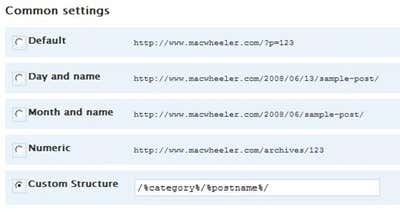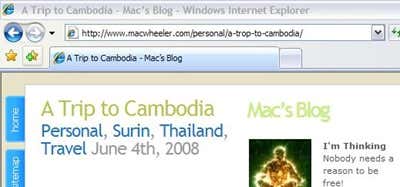Basic WordPress SEO
Today I am going to look at some very basic first steps in making sure that your band new shiny WordPress installation is search engine friendly. I am going to talk about just two things, but these are very important things, the most fundamental and arguably the most valuable from an SEO viewpoint.
Firstly we are going to talk about permalinks. When you first install WordPress, your permalink structure will create a page URL for your posts and pages that looks something like this:
http://www.yoursite.com/?p=123
This is far from optimal, we really need to change this to something that contains some tasty and readable information for the search engines to devour. So we will make some changes to have them look like this:
http://www.yoursite.com/category/post-name/
To do this, find the permalinks section of your blog options and make the changes in the screenshot below. Before doing so, make sure you .htaccess file has write permissions set, don’t forget to change it back afterwards!
Next we move on to page title, the default WordPress install will display a page title in this format:
Name Of Blog – Blog Archive – Post Title
This is terrible, since search engines rely heavily upon the page title. The attribute more weight to keywords at the front of the title, so we need to switch “Blog Title” and “Post Title” around at the very least. This is where it gets tricky and much will depend on a) the version of WordPress you are using and b) the theme you are using.
Basically you need to look in your header.php and locate a line of code (usually towards the top) that will look something like this:
You then need to change it to something that looks like this:
And there we have it, nice search engine friendly page titles.
These two basic changes are the logical first step in creating a fully SEO optimised WordPress blog. Both of these simple changes will have a huge impact on your on the page SEO, they address 2 of the top 3 SEO factors (the first being the actual domain name).
In the screenshot above we can see the results of these changes, check the search engine friendly URL and the improved page title.
Firstly we are going to talk about permalinks. When you first install WordPress, your permalink structure will create a page URL for your posts and pages that looks something like this:
http://www.yoursite.com/?p=123
This is far from optimal, we really need to change this to something that contains some tasty and readable information for the search engines to devour. So we will make some changes to have them look like this:
http://www.yoursite.com/category/post-name/
To do this, find the permalinks section of your blog options and make the changes in the screenshot below. Before doing so, make sure you .htaccess file has write permissions set, don’t forget to change it back afterwards!
Next we move on to page title, the default WordPress install will display a page title in this format:
Name Of Blog – Blog Archive – Post Title
This is terrible, since search engines rely heavily upon the page title. The attribute more weight to keywords at the front of the title, so we need to switch “Blog Title” and “Post Title” around at the very least. This is where it gets tricky and much will depend on a) the version of WordPress you are using and b) the theme you are using.
Basically you need to look in your header.php and locate a line of code (usually towards the top) that will look something like this:
You then need to change it to something that looks like this:
And there we have it, nice search engine friendly page titles.
These two basic changes are the logical first step in creating a fully SEO optimised WordPress blog. Both of these simple changes will have a huge impact on your on the page SEO, they address 2 of the top 3 SEO factors (the first being the actual domain name).
In the screenshot above we can see the results of these changes, check the search engine friendly URL and the improved page title.










